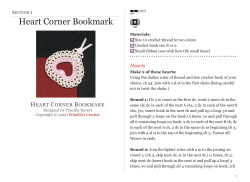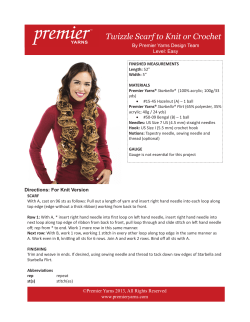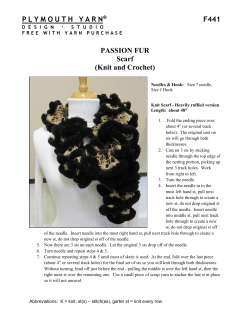
Albright Knot
Albright Knot Tied to connect two different sizes of monofilament together, or connecting monofilament to spectra. Very popular for tying a leader onto a marlin or swordfish casting outfit. When used in connecting spectra to monofilament increase number of turns to 21 in step 2. The spectra should also be doubled with a Bimini Twist knot prior to tying the Albright. 1. Bend a loop in the tag end of the heavier monofilament and hold between thumb and forefinger of left hand. Insert the tag end of the lighter monofilament through loop from the top. Pull the standing part of the heavy mono and the standing part of the light mono. 2. Slip tag end of lighter monofilament under your left thumb and pinch it tightly against the heavier strands of the loop. Wrap the first turn of the lighter monofilament over itself and continue wrapping toward the round end of the loop. Take at least 12 turns with the lighter monofilament around all three strands. 3. Insert tag end of the lighter monofilament through end of the loop from the bottom. It must enter and leave the loop on the same side. 4. With the thumb and forefinger of the left hand, slide the coils of the lighter monofilament toward the end of the loop, stopping 1/8” from end of loop. Using pliers, pull the tag end of the lighter mono tight to keep the coils from the slipping off the loop. 5. With your left hand still holding the heavier mono, pull on the standing part of the lighter mono. Pull the tag end of the lighter mono and the standing part a second time. 6. Trim both tag ends. 1 2 3 4 5 6 Blood Knot Used for splicing lines of similar size. Not recommended for use in spectra connections. 1. Take the two lines’ ends and tie a simple overhand knot (which will be clipped off later). Then tighten to combine the two lines into one. 1 2. Form a loop where the two lines meet, with the overhand knot in the loop. Pull one side of the loop down and begin taking turns with it around the standing line. Keep point where turns are made open so turns gather equally on each side. 2 3. After eight to ten turns, reach through center opening and pull remaining loop (and overhand knot) through. Keep finger in this loop so it will not spring back. Hold loop with teeth and pull both ends of line, making turns gather on either side of loop. 4. Set knot by pulling lines tightly as possible. Tightening coils will make loop stand out perpendicular to line. Then clip off the loop and overhand knot close to the newly formed knot. 3 4 1 2 3 4 Bimini Twist Knot 5 Tied to form a double line. Can be tied short for bait fishing large tuna to provide for extra abrasion resistance at the gill plate. Also tied as a shock leader for big game trolling and for loop to loop spectra or wind on connections. 1. Measure a little more than twice the footage you’ll want for the double-line leader. Bring end back to standing line and hold together. Rotate end of loop 20 times, putting twists in it. 2. Spread loop to force twists together about 10” below tag end. Step both feet through loop and bring it up around knees so pressure can be placed on column of twists by spreading knees apart. 6 3. With twists forced tightly together, hold standing line in one hand with tension just slightly off the vertical position. With other hand, move tag end to position at right angle to twists. Keeping tension on loop with knees, gradually ease tension of tag end so it will roll over the column of twists, beginning just below the upper twist. 4. Spread legs apart slowly to maintain pressure on loop. Steer tag end into a tight spiral coil as it continues to roll over the twisted line. 5. When spiral of tag end has rolled over column of twists, continue keeping knee pressure on loop and move hand which has held standing line down to grasp knot. Place finger in crotch of line where loop joins knot to prevent slippage of last turn. Take half-hitch with tag end around nearest leg of loop and pull up tight. 7 6. With half-hitch holding knot, release knee pressure but keep loop stretched out tight. Using remaining tag end, take half-hitch around both legs of loop, but do not pull tight. 7. Make two more turns with the tag end around both legs of the loop, winding inside the bend of line formed by the loose half-hitch and toward the main knot. Pull tag end slowly, forcing the three loops to gather in a spiral. 8. When loops are pulled up neatly against main knot, tighten to lock knot in place. Trim tag end about 1/4” from knot. 8 1 Dropper Loop Knot Used to tie a loop in the line above the sinker, or for tying a gangion of hooks. You can also cut one side of the finished loop to use only a single line to your hook. 1. First, form a loop in the line. 2. Pull one side of the loop down and begin taking turns with it around the standing line. Keep point where turns are made open so turns gather equally on each side. 3. After eight to ten turns, reach through center opening and pull remaining loop through. Keep finger in this loop so it will not spring back. 2 3 4. Hold loop with teeth and pull both ends of line, making turns gather on either side of loop. 4 5. Set knot by pulling lines as tightly as possible. Tightening coils will make loop stand out perpendicular to line. 5 Improved Clinch Knot Very popular general purpose knot for attaching a swivel or hook to the end of a line. Line can be doubled before tying the knot for improved strength. 1 1. Pass the line through the eye of the hook, swivel, or lure. Double back and make five turns around the standing line. 2 2. Holding the coils in place, thread the tag end of the first loop above the eye, then through the big loop. 3 3. Hold the tag end and standing line while pulling up the coils. Make sure the coils are in a spiral, not overlapping each other. Slide against the eye. Clip the tag end. Offshore Swivel Knot Tied to connect a swivel to the end of a double line. 1 1. Slip loop end of double-line leader through eye of swivel. Rotate loop end a halfturn to put a single twist between loop and swivel eye. 2 2. Pass the loop with the twist over the swivel. Hold end of the loop, plus both legs of the double-line leader with one hand. Let swivel slide to other end of double loops now formed. 3 3. Still holding loop and lines with one hand, use other to rotate swivel through center of both loops, at least six times. 4. Continue holding both legs of double-line leader tightly but release end of loop. Pull on swivel and loops will begin to gather. 5. To draw knot tight, grip swivel with pliers and pull loops toward eye with fingers, while still keeping standing lines of the leader pulled tight 4 5 Palomar Knot 1 2 3 4 Excellent high strength knot for attaching a hook or lure. 1. Double about 4” of line and pass loop through eye. 2. Let hook hang loose and tie overhand knot in doubled line. Avoid twisting the lines and don’t tighten knot. 3. Pull loop of line far enough to pass it over hook, swivel or lure. Make sure loop passes completely over this attachment. 4. Pull both tag end and standing line to tighten. Clip about 1/8”. Perfection Loop Knot 1 2 Tied to allow a free swinging hook connection, to space the hook back in a trolling lure, or to tie a loop in the end of a line. Popular knot used by Mexican cruiser and panga fisherman. Sometime referred to as the Mexican loop knot. Can be tied in heavy monofilament leader too. Can be used to attach a lure that needs a free connection, like using a leadhead on a swimbait. 1. Form a loop with standing portion behind. Grip crossing section with thumb and forefinger. 2. Turn tag end around front of loop to create a second loop. 3. Lay tag end in valley between two loops. 3 4 4. Slip second loop through first loop pulling slowly, but steadily to close final knot. Snell Knot Snell knot is used for a solid connection to your hook. Also used to tie a double rig for halibut fishing. In step 2, make sure the wraps lay parallel to each other and do not cross over. 1 1. Insert one end of the leader through the hook’s eye extending one to two inches past the eye. Insert the other end of the leader through the eye in the opposite direction pointing toward the barb of the hook. Hold the hook and leader ends between thumb and forefinger of your left hand. Leader will hang below the hook in a large loop. 2. Take the part of this loop that is closest to the eye and wrap it over the hook shank and both ends of the leader toward the hook’s barb. Wrap for 7 or 8 turns and hold wraps with left hand. Grip the end of the leader that is through the eyelet with your right hand and pull it slowly and steadily. Hold the turns with your left hand or the knot will unravel. 3. When knot is almost tight, slide it up against the eye of the hook. Grip the short end lying along the shank of the hook with a pair of pliers. Pull this end and the standing line at the same time to completely tighten the knot. Trim the tag end. 2 3 San Diego Knot 1 San Diego jamb knot made popular by the long range fleet. High strength knot for attaching a hook, swivel or lure to your line. Line can be doubled before tying to increase strength in heavier lines. 2 1. Pass the line through the eye of the hook, swivel, or lure. Double back over the main line. 2. Begin making turns over the main line. The number of turns varies with line size, from 8 turns with 10lb line down to 3 turns with 40 lb. 3 3. Complete the appropriate number of turns, then thread the tag end of the first loop above the eye. 4. Holding the coils in place, pass the tag end through the loop created by the last coil of the knot. 4 5. Hold the tag end and standing line while pulling up the coils. Make sure the coils are in a spiral, not overlapping each other. Slide against the eye. Clip the tag end. 5 Spider Hitch Knot 1 Spider Hitch knot is used to tie a double line or dropper loop. Good quick knot to tie a double line. Not recommended for use in spectra lines. For a high strength dropper loop use this knot and tie the sinker on the tag end. In step 3 be sure to pull the loop so the turns come off your finger in order. 2 1. Form a loop of the leader length desired. Near the point where it meets the standing line, twist a section into a small reverse loop. 3 4 2. Hold small loop between thumb and fore-finger with thumb extended well above finger and loop standing out beyond end of thumb. 3. Wind double line around both thumb and loop, taking five turns. Pass remainder of large loop through the smaller one and pull to make five turns unwind off the thumb. 4. Pull turns around the base of the loop up tight and snip off tag end Surgeon’s Knot Surgeon’s Knot is used for connecting two different diameter lines. See also Albright Knot. 1. Lay line and leader parallel, overlapping 6” to 8”. 2. Treating the two like a single line, tie an overhand knot, pulling the entire leader through the loop. 3. Leaving the loop of the overhand open, pull both tag end of line and leader through again. 4. Hold both lines and both ends to pull knot tight. Clip ends close to avoid foul-up in rod guides. 1 2 3 4 Trilene Knot 1 1. Run end of line through eye of hook or lure and double back through the eye a second time. 2 2. Loop around standing part of line 5 or 6 times. 3 3. Thread tag end back between the eye and the coils as shown. 4. Pull up tight and trim tag end. 4 Uni Knot Uni knot, a very strong multi purpose knot for attaching a hook, swivel or lure. Can also be tied back to back to connect similar size lines, or spectra to monofilament line. If you want to keep a loop so your lure or hook remains free swinging, adjust your loop in step three, then snug up on the tag end. The knot will then pull down under the pressure of fighting a fish. With a little practice this knot can be tied in the dark, making it even more versatile. 1 1. Run at least six inches of line through the eye of the hook, swivel, or lure, and fold to make two parallel lines. Bring the tag end of the line back in a circle toward the hook or lure. 2 2. Make six turns with the tag end around the double line and through the circle. Hold the double line at the point where it passes through the eye, and pull the tag end to snug up the turns. 3 3. Hold the double line at the point where it passes through the eye, and pull the tag end to snug up the turns. 4 4. To create a snug knot: Pull the standing line to slide the knot up against the eye. Then continue pulling until the knot is tight. Trim the tag end flush with the closest coil on the knot Double Uni Knot Awesome knot for connecting two lines of similar diameter. Can be used to connect spectra to mono also. It is recommended to tie a double in the Spectra before tying the knot if the diameters are very different. A 1. Overlap about 12 inches of the ends of two lines. Form a Uni-Knot circle with the tag end of line “A.” 2. Wrap line “A” five times to form a Uni-Knot around line “B.” 3. Snug the knot by gently pulling on both ends of line “A” with enough tension to close the wraps, but not so tight that it actually grips line “B.” A 4. Form a new Uni-Knot circle with the tag end of line “B” and wrap line “B” five times to form a Uni-Knot around line “A.” (Use only four turns for 60-, 80-, or 100-poundA test monofilament.) 5. Gently pull line “B” with one hand and line “A” with the other to slide the two Uni-Knots together until they jam--then pull tight. Then tighten the wraps around the standing lines by firmly pulling the tag ends of each Uni-Knot. Snip the tag ends. B B 1 2 3 B 4 5
© Copyright 2025









